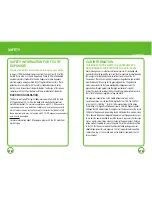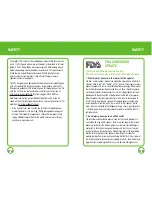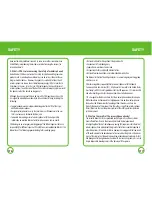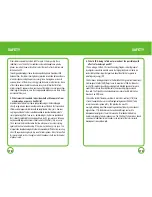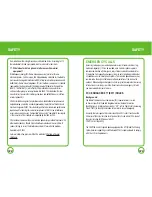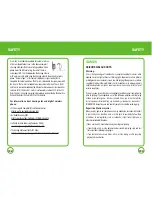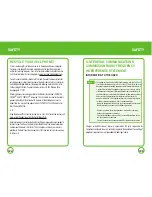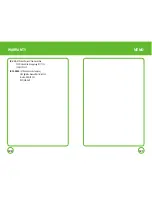
130
131
SAFETY
SAFETY
ADAPTER/CHARGER
CHARGER
The charger designed by UTStarcom for this unit requires the use of a standard
120 V AC power source for its operation.
• Never attempt to disassemble or repair a charger.
• Never use a charger if it has a damaged or worn power cord or plug.
Always contact a UTStarcom authorized service center, if repair or replacement
is required.
• Never alter the AC cord or plug on your charger. If the plug will not fit into the
available outlet, have a proper outlet installed by a qualified electrician.
• Never allow any liquids or water to spill on the charger when it is connected to
an AC power source. Always use the authorized UTStarcom charger to avoid
any risk of bodily injury or damage to your cellular phone or battery.
• Never attempt to connect or disconnect the charger with wet hands.
Always unplug the charger from the power source before attempting any
cleaning. Always use a soft cloth dampened with water to clean the equipment,
after it has been unplugged.
Handling the cord on this product or cords associated with accessories sold with
this product, will expose you to lead, a chemical known to the State of California
to cause birth defects or other reproductive harm. Wash hands after handling.
Always disconnect the charger from the power source when it is not in use.
Handling the cord on this product or cords associated with accessories sold with
this product, will expose you to lead, a chemical known to the State of California
to cause birth defects or other reproductive harm. Wash hands after handling.
Always disconnect the charger from the power source when it is not in use.
FCC HEARING-AID COMPATIBILITY
(HAC) REGULATIONS FOR WIRELESS
DEVICES
On July 10, 2003, the U.S. Federal Communications Commission (FCC) Report
and Order in WT Docket 01-309 modified the exception of wireless phones under
the Hearing Aid Compatibility Act of 1988 (HAC Act) to require digital wireless
phones be compatible with hearing-aids. The intent of the HAC Act is to ensure
reasonable access to telecommunications services for persons with hearing
disabilities.
While some wireless phones are used near some hearing devices (hearing aids
and cochlear implants), users may detect a buzzing,humming, or whining noise.
Some hearing devices are more immune than others to this interference noise, and
phones also vary in the amount of interference they generate.
The wireless telephone industry has developed a rating system for wireless
phones, to assist hearing device users find phones that may be compatible with
their hearing devices. Not all phones have been rated. Phones that are rated
have the rating on their box or a label located on the box. The ratings are not
guarantees. Results will vary depending on the user’s hearing device and hearing
loss. If your hearing device happens to be vulnerable to interference, you may not
be able to use a rated phone successfully. Trying out the phone with your hearing
device is the best way to evaluate it for your personal needs.
M-Ratings: Phones rated M3 or M4 meet FCC requirements and are likely to
generate less interference to hearing devices than phones that are not labeled.
M4 is the better/higher of the two ratings.
Hearing devices may also be rated. Your hearing device manufacturer or hearing
health professional may help you find this rating. Higher ratings mean that the
aring device is relatively immune to interference noise. The hearing aid and
wireless phone rating values are then added together.






